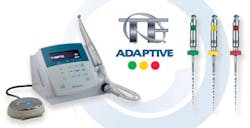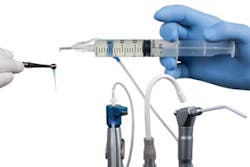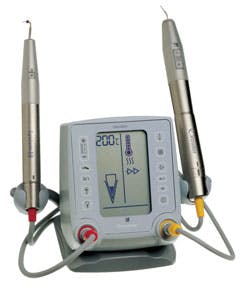Lauding a new endo technique
by Michael DiTolla, DDS, FAGD
I have known for a while that I needed to update my endo technique. Like the vast majority of you, in dental school I was taught to shape canals with Hedstrom hand files, irrigate with sodium hypochlorite in a disposable syringe, and obturate with gutta percha using lateral condensation – not the picture of efficiency.
After a few weeks of investigation, I settled on Axis|Sybron Endo and its TF Adaptive system with the Elements motor for instrumentation, the EndoVac system for irrigation, and the Elements Obturation system. The good news is you can get better results with less effort for the same fee. That's what technology is supposed to do.
When set on TF Adaptive, the Elements motor (Fig.1) rotates clockwise, and depending on the load on the file, adapts and reverses counter-clockwise by coasting in a reciprocal motion. This keeps excessive stress off the file and avoids the "screw-in" effect of pure rotary systems.
I am able to treat almost all teeth with just two files – one to create the desired taper and one to enlarge the apical portion of the canal. Three files are provided and are color-coded to a traffic signal, which my assistants love. To me, shaping has never been simpler.
EndoVac (Fig.2) is a negative pressure irrigation system. The MicroCannula can reach the canal working length, and provides suction through small openings around its tip while the sodium hypochlorite is introduced from the top of the canal. Irrigant can finally get to the apical 3 to 4 mm of the canal with no fear of extruding past the apex. Search "EndoVac Animation" on YouTube to see it in action.
The Elements Obturation unit (Fig.3) is two instruments in one. The System B handpiece is used for downpack, backfill, and as a heat source for vitality testing. The System B pluggers match the canal shape and maximize condensation forces, moving gutta percha and sealer into all areas of the canal, including lateral canals. The other instrument, the extruder, uses disposable cartridges to deliver gutta percha. Filling the entire coronal two-thirds of the canal with dense, void-free gutta percha in three seconds is an amazing feeling.
If you have ever wished that endo could be done with three or less files, wished you could safely get irrigant to the apex, or wished you could fill lateral canals as you have seen in magazines, then you should go to www.sybronendo.com and get a demo.
Michael DiTolla, DDS, FAGD, is the director of clinical research and education at Glidewell Laboratories in Newport Beach, Calif. He lectures nationwide on both restorative and cosmetic dentistry. Dr. DiTolla has several free clinical programs available on DVD through Glidewell Laboratories or online at www.glidewelldental.com.



